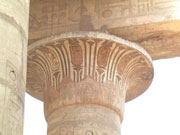TOUR NEWS - AMARNA EGYPT NOVEMBER-DECEMBER 2006
The B.C. Archaeology Tour of Amarna Egypt in November-December 2006 was a great success with everyone enjoying our exploration of the remarkable sites connected with the Amarna Period. There were 13 of us on the tour which included Martin Roulston, Joan Kelleher, their son Adam Kelleher-Roulston and Peter Maddern from Melbourne, Liz Anderson from Adelaide, and Angela La Loggia, Sue Turner, Connie Lord, Deborah Russell, and Barbara and Barry Bryett from Sydney. The group leader was Dr Michael Birrell and the Egyptian guide was Mohamed Aziz (otherwise known just as Aziz).
The tour began in Cairo where we stayed a few days at the Pearl Hotel in the southern suburb of Maadi. We arrived at Cairo International Airport in the early morning and after checking into the hotel we had some breakfast in a local caf�. The afternoon was taken up with an informal visit to the Cairo Museum which gave everyone a taste of Egyptian culture. A beer at the Grand Caf� near the Nile was an excellent end to the day.
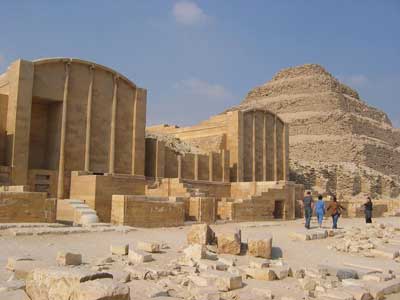 |
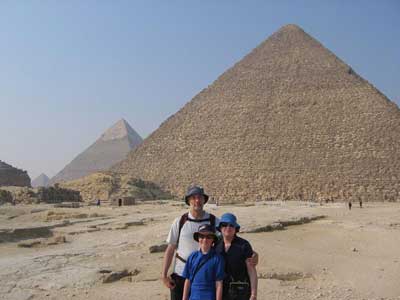 |
The Step Pyramid of King Zoser at Saqqara |
Exploring the wonders of Giza |
At Saqqara we had a chance to see the newly opened Imhotep Museum. This excellent little Museum is dedicated to artefacts found at the site and includes many pieces never previously on display to the public. We also saw the Third Dynasty Step Pyramid of Zoser and made a quick dash across the desert to see the well preserved tombs of the Amarna Period, including the beautiful tomb of the General Horemhab, military leader during the reign of Tutankhamun. In the afternoon we visited the Old Kingdom mastaba tombs of Mereruka and Kagemni and the colossus of Ramesses II at Memphis.
The following morning was spent at Giza where we walked around the outside of the Great Pyramid of Khufu. Some of the group went for a camel ride around the area to experience the superb desert scenery. We visited the pyramid of Khafre where some of the group went inside. Lunch was spent at a Giza caf� with a great view of the pyramids. In the afternoon we headed off to the Khan el-Khalili for a first visit to these exciting markets.
The next day we went south through the western desert to the edge of the Fayyum Oasis. Here we saw the extensive ruins of the Roman Period town of Karanis which preserves remains of two stone temples, ruined houses and baths (Adam tried the Roman bath for size!). Lunch was spent in a restaurant at the edge of the picturesque Fayyum Lake. In the afternoon we stopped to have a look at the pyramid of Senwosret II at Lahun where we climbed part of the way up the ruins. The pyramid is set in a dramatic desert landscape above the cultivation and Angela took a particular interest in the mudbricks (customs may have had a problem if she'd bought back a souvenir!). A brief visit to the ruins of Kahun resulted in the discovery of numerous artefacts including a dolerite pounder and worked granite fragments.
We then packed our bags and headed south on the early morning First Class train from Cairo to Minya. After checking into our new hotel (the Cleopatra) we had some lunch and in the afternoon we visited the ancient city of Akhoris, now called Tehna el-Gebel. Here we saw the dramatic temple built by the Roman Emperor Nero, the ruins of this Roman city, and enjoyed the superb view over the agricultural zone.
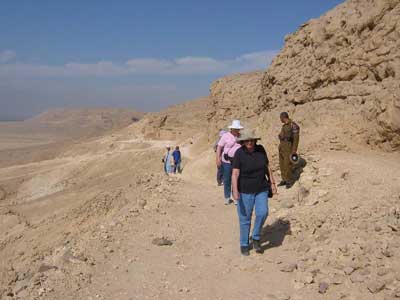 |
 |
Exploring the tombs at Amarna |
Early morning on the Nile at Amarna |
The next day we crossed the river and headed south of Minya to see a number of sites on the east bank. The first stop was Beni Hasan where we saw the beautiful painted tombs of the 11th and 12th Dynasties. Numerous attempts were made to take photographs with some success (the guards are sticklers for the no-photographs-in- the-tombs rule but some of us managed to get some decent photos - without flash of course! Well done Angela!). We had a picnic lunch in the caf� at Beni Hasan before we headed into the desert to see the rock cut temple of Queen Hatshepsut of the 18th Dynasty. On our return to Minya we saw the ancient city and tombs of Hebenu, modern Kom el-Ahmar. Almost everyone wanted to climb down the wooden ladder into the Tomb of Nefer-sekheru.
A highlight of the tour was the two days spent at the ruins of Akhetaten (modern Amarna), the ancient royal capital built by King Akhenaton. We started our visit by looking at the superb North Tombs with their stunning painted reliefs and view across the desert plain. We then went to see the Royal Tomb and in the afternoon saw Boundary Stelae U, carved by Akhenaton to define the limits of his new city. The next day we came back to explore the ruins of the ancient city buildings including the temples to the Aten and the Royal Palace - the group enjoyed looking for the distinctive Amarna blue painted pottery, with some success! The afternoon was spent in the South Tombs where we read the Hymn to the Aten in the tomb of Ay. The river crossing to Amarna is very tranquil and evocative and a wonderful way to approach this historic place.
The following morning we travelled to the modern town of Malawi where we stopped to see the local Museum - the locals were impressed that someone wanted to buy their replica Amarna statues. We then went to nearby Tuna el-Gebel where we have a picnic lunch. Here we saw the painted Ptolemaic tombs, including the famous Greek tomb of Petosiris, the Boundary Stela of Akhenaton, and the atmospheric underground galleries housing the mummified remains of the sacred ibises and baboons of Thoth. We then visited the ancient site of Khmun, modern Ashmunein, and saw the ruins of the temple of Thoth and the Christian cathedral of the 5th Century.
 |
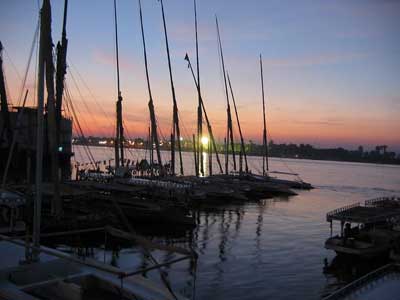 |
Exploring Luxor Temple |
Sunset at Luxor - perfect! |
The following day we caught the First Class train to Luxor. We spent a week in Luxor exploring the many local sites. This included the ruins of the Temple of Luxor, located in the heart of the modern city. We saw the Colossi of Memnon (two monumental seated statues of King Amenhotep III) and the Palace of Malkata, built by Amenhotep III for the celebration of his Jubilee Festivals. We also saw some of the painted tombs of the 18th Dynasty in the Theban Hills. A day at Karnak Temple enabled us to concentrate on the Amarna Period remains and scenes. We also walked across the Theban Hills and saw the superb Mortuary temple of Queen Hatshepsut of the 18th Dynasty, including the recently opened Third Terrace. We also toured the Valley of the Kings and took the opportunity to explore the seldom visited tomb of King Ay in the West Valley.
A number of day trips from Luxor enabled us to explore nearby sites of historical value. These included the mortuary temples of Sety I and Ramesses II at Abydos, the impressive Ptolemaic Temple of Hathor at Dendera and the magnificent painted tombs of the 18th Dynasty at el Kab. We then flew back to Cairo where we had an afternoon exploring the Mosques of the Old City and spent a day in the Cairo Museum. A very enjoyable tour, with much interest and enthusiasm from the group. The end of tour quiz was hotly contested by all!
Michael Birrell
